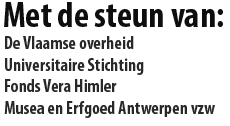N. BOERMA
De 17de-eeuwse Nederlandse kinderprent
Summary: The Dutch children’s print of the seventeenth century: comic strip or only a precursor?
At the exhibition in Venlo Suske and Wiske the story tellers fl& of phantasy is exposed a print the Life of Klaas and Griet. Klaas is a softie, who is beaten by his wife Griet, who really is a “dulle Griet” and who is forced to do humiliating female work. A different version of this picture story is titled Children with great pleasure you see the Life of an and Griet. Such a picture story about squabbles in a marriage could be a subject of a children’s print. When we research the phenomenon of the children’s print, it appears that the farm Bouman round 1673 was the first to print picture stories especially intended for children, 75 years earlier than everywhere in Europe.
This study is about the early Dutch children’s prints with picture stories: are they already comic strips or only their precursors? Taking a starting-point the definition of a comic strip as a series of graphic images which are so organized that they convey a continuing action in a deliberate sequence, we conclude that most of the picture stories are precursors because the sequence of the graphic images can be arbitrary. But in the picture story of Jan the Washer a deliberate sequence is growing and the picture story of the unhappy marriage of Urbanus and Isabel hos that deliberate sequence that covers a continuing action and so meets the requirements of a full grown comic strip. The early Dutch children’s print is thus an important link in the development of the comic strip.
.
P. LEFEVRE
Zelfreflexieve vertelstrategieën in Willy Vandersteens Suske en Wiske (1945-1971)
Summary: Self-reflexive techniques in Willy Vandersteen’s Suske en Wiske (1945-1971)
Though the Flemish comic strip Suske en Wiske is still running, this artide limits itself to the first 71 stories Suske en Wiske that Willy Vandersteen (1913-1990) pub-lished in the Flemish newspapers De Nieuwe Standaard and De Standaard between 1945 and 1971. In English only a very limited amount of stories are available under various tides as Willy and Wanda, Bob and Bobette, Spike and Suzy. Suske en Wiske has a unity and a set of concrete formal techniques, evolving in time. Though Vandersteen did not create many new narrative techniques, his combination of a continuity strip with various forms of humor (induding self-referential strategies), a (fake) family setting, wild imagination and criticism of hot topics is quite unique for its time.
This study focuses on the self-reflexive or autoreferential techniques in Suske en Wiske. On the basis of Thierry Groensteen’s theoretical model nandes désignées. De la réflexivité dans les bandes dessinées’, in: Contrebandes, 13/14 (1990), p. 132- 165) the various occurrences in the comics series were dassified and discussed. In general the self-reflexive techniques function only as a short humoristic interruption of the linear course of the story, only exceptionafly they undermine a complete story as in De Briesen& Bruid. The self-reflexive inserts are quite frequent in the comic strips, but absent in the eight stories Vandersteen created for the weekly Tintin I Kuifie. In fact, such self-reflexive are rather unusual in French language comics of the same period, not only in the adventure comics as Tintin, Blake et Mortimer, Alix, but also in the humour series as Spirou or Lucky Luke. On the contrary such self-reflex-ive instances are far more common in Flemish comic strips as comic strips Nero or Piet Pienter en Bert Bibber (and later Kiekeboe and Urbanus).
.
P. MOLS
Bekijk het maar. Het beeld als venster op de werkelijkheid
Summary: The image as window on reality
In the world we live in nowadays, we are surrounded by pictures. The amount of visual information is enormous. These images in commercials, in newspapers and the internet, on television and billboards, in arts and heritage are on the one hand totally different. But they have also one thing in common: They are all made by someone on purpose with a particular goal. Every picture tells a story of the way the maker of the image looks upon the world. In that way we can meet the particular way of seeing of the maker through the image. In that way every image opens a possible window upon reality.
If we see images as windows upon reality, the collection of images that surround us become a learning spot. In fact an enormous collection of ways of seeing reality. And by using this side of images in museums, educational programs, heritage-projects and others, we could actualize the way we look upon the world we live in, in a more multi-focused way. And that is how images could enrich live.
.
R. DAENEN
Een kleine geschiedenis van de strip
Summary: A brief history of comics
Quite different than photography or movies, there cannot be a dear `father’ of mod-ern comics distinguished. Generafly, scholars situate the starting point of the histo-ry of comics at the end of the 19’h century. At this time many elements – such as technical, sociological and commercial developments, to name just a few – con-verged and made the enormously rapid development of comics possible, especially in the United States. Comics became an important commercial instrument for news-papers, and later on, syndicates, editors and others… There were big differences between American and European comics however. In Europe, and especially Belgium and France, comics were until the sixties of last century aimed at children and youngsters. As a consequence, comics were considered as a part of popular cul-ture and didn’t get a lot of attention of scholars. But times have changed and there’s a fascinating history to discover now. This artide makes a swift synthesis of this his-tory and points out some of the most influential Western authors.
.

